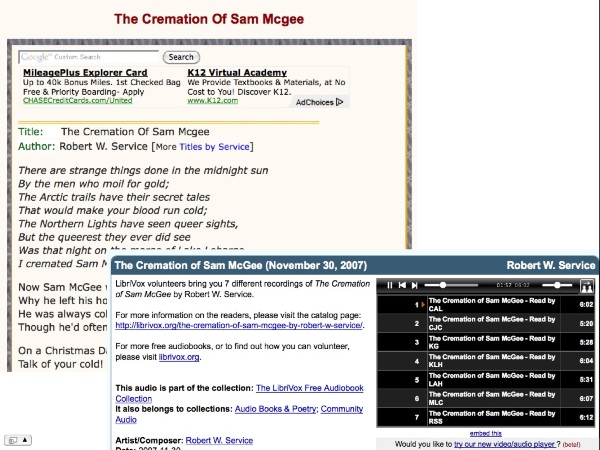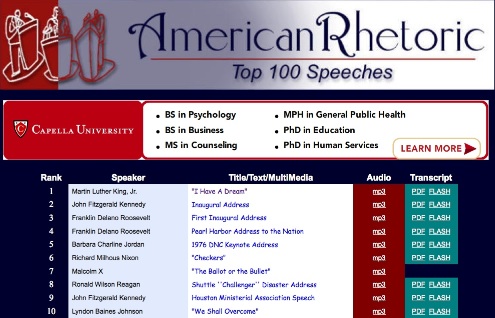Choral Reading and Great Speeches
 |
About the presenter: Judith Kuster M.S. in speech-language pathology and M.S. in counseling, is an ASHA Fellow and emeritus professor of Communication Disorders at Minnesota State University, Mankato. She is the webmaster for the Stuttering Home Page as well as the coordinator of this online conference. She is a member of the ASHA Special Interest Group #4: Fluency and Fluency Disorders. She is the recipient of the ASHF DiCarlo Award for Outstanding Clinical Achievement, the 2003 Distinguished Contributor Award from the International Fluency Association, a 2007 Outstanding Contribution Award from the International Stuttering Association, the 2008 ASHA Distinguished Contributor Award, and in 2009 was named to the National Stuttering Association's Hall of Fame. |
Choral Reading and Great Speeches
by Judith Maginnis Kuster
from Minnesota, USA
Clients who stutter sometimes report an advantage of spending 15 to 20 minutes each morning, reading aloud to themselves. They claim that it "gets their articulators moving" and reminds them of the feeling of "forward moving speech." Some may have also experienced increased confidence and desensitization to reading aloud from this exercise. Whatever the effect, some people who stutter find reading aloud to themselves each morning, helpful. Malcolm Fraser, in his book Self Therapy for the Stutterer recommended "Practice talking smoothly and easily by reading aloud when alone for five to ten minutes a day. Read in a firm voice but keep your speech movements loose and relaxed" (p. 67). James Earl Jones worked to overcome his stuttering by reading Shakespeare "aloud in the fields to myself," and then reading to audiences, and then acting. Jones went on the be a great Shakespearen actor, but better known as the voice of Darth Vader in "Star Wars." Part of Vice President Biden's self-therapy included reading aloud in front of a mirror.
A well-documented fluency enhancer, choral reading (Bennett, p. 71-73; Bloodstein and Ratner, p. 262-263; Ham, p. 318-324; Manning, p. 341; Van Riper, p. 79-80), is "sometimes used in stuttering therapy" (Nicolosi, Harryman, and Kresheck, Janet, p. 57). Although Conture warns, "it should be noted that giving early, concrete examples to an adult who stutters that change is possible in his or her speech is not without its problems, and these need to be discussed," he states, that "choral reading . . . can be used to show that: (1) the adult client's speech disfluency is malleable, it's not a fixed, never-changing property etched in stone for all time; (2) that speech fluency, given certain circumstances is obtainable. . ." (p. 293).
The internet provides an opportunity to combine "reading aloud" practice with choral reading. There are several opportunities to read along with an online audio and text. Use a search engine to find a text and audio recording on various sites.
For example, The Cremation of Sam McGee text is available online a http://www.readbookonline.net/readOnLine/43135 and the audio is available at http://www.archive.org/details/cremationsammcgee_0711_librivox

A bit more challenging, but a different opportunity is to find audio recordings of actual speeches online accompanied by the text. For example, American Rhetoric (http://www.americanrhetoric.com/newtop100speeches.htm) is a repository of both the audio (in mp3) and written transcript (in PDF) of the "top 100 speeches." Some are real, historical speeches, others are speech examples from the movies.

Explore them all, but two from American Rhetoric are provided below.
The first example is from Dr. Martin Luther King, Jr's famous 16 1/2 minute "I Have a Dream" speech, delivered 28 August 1963, at the Lincoln Memorial, Washington D.C
AUDIO ONLY (http://ia700402.us.archive.org/29/items/MLKDream/MLKDream_64kb.mp3)
TEXT and AUDIO (http://www.americanrhetoric.com/speeches/mlkihaveadream.htm)
You might want to run off a copy of the text and mark the pauses as you listen to the speech for the first time

The next example is from a movie script.
James Earl Jones as Clarence Mann in the 1989 movie, "Field of Dreams" (2 minutes)
AUDIO (http://www.americanrhetoric.com/mp3clips/newmoviespeeches/moviespeechfieldofdreams325325329.mp3)
TEXT (http://www.americanrhetoric.com/MovieSpeeches/moviespeechfieldofdreams.html)

The final example is very familiar to the community of people interested in stuttering!
The 5:45 minute broadcast by George VI "to his people in Britain, and throughout the Empire, immediately after Britain's Declaration of War against Germany on September 3, 1939."
AUDIO and TEXT (http://www.awesomestories.com/assets/george-vi-sep-3-1939)

A final suggestion - when the client has become very comfortable with choral reading any of the online speeches or book selections, suggest that he reduce the volume, attempting to maintain the pace of the text. If fluency breaks down, increase the volume again to renew the choral reading effect. If he can become adept at this, suggest he invite another person to listen.
References
Bennett, Ellen (2006) Working with People Who Stutter: A Lifespan Approach, Upper Saddle River, New Jersey: Columbus, Ohio
Bloodstein, Oliver and Ratner, Nan Bernstein, (2008), A Handbook on Stuttering 6th edition, Canada: Thomson-Delmar Learning
Conture, Edward (2001), Stuttering: its nature, diagnosis, and treatment Allyn and Bacon
Fraser, Malcolm, Self-Therapy for the Stutterer, Stuttering Foundation of America
Ham, Richard (1986) Techniques of Stuttering Therapy, Englewood Cliffs, New Jersey: Prentice-Hall
Manning, Walter (2000) Clinical decision-making in fluency disorders Singular
Nicolosi, Lucille; Harrymam, Elizabeth; and Kresheck, Janet (1996) Terminology of communication disorders: speech-language-hearing Williams and Wilkins

